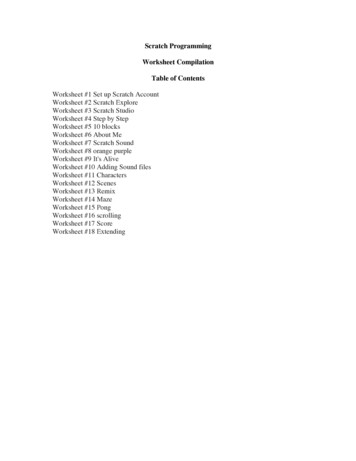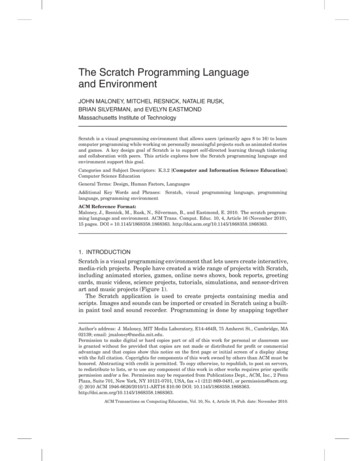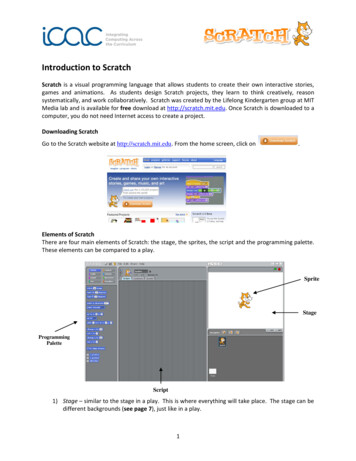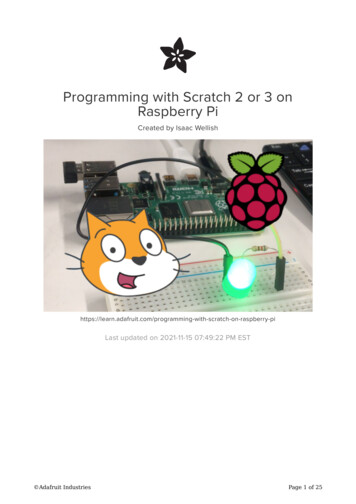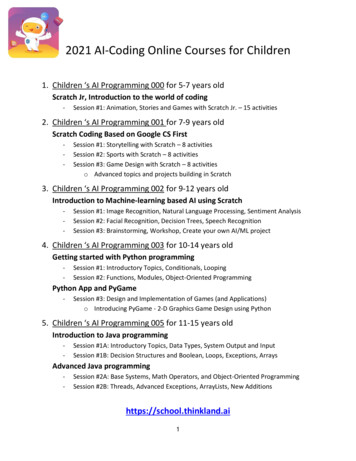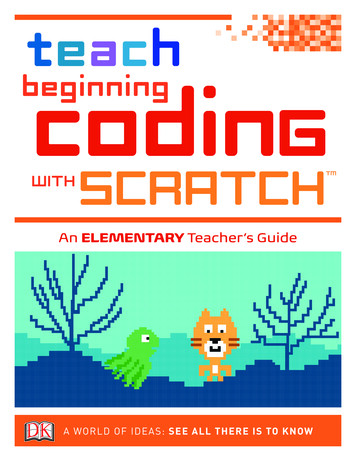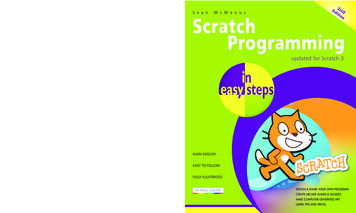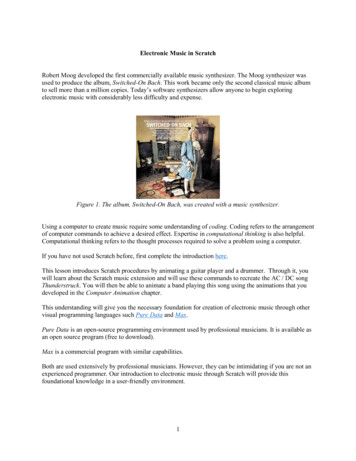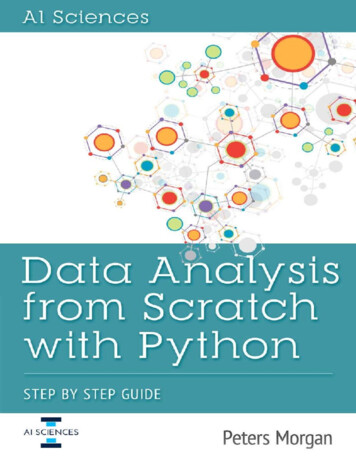
Transcription
D ATA A N A LY S I S F R O M S C R AT C H W I T H P Y T H O NStep By Step GuidePeters Morgan
How to contact usIf you find any damage, editing issues or any other issues in this book containplease immediately notify our customer service by email at:contact@aiscicences.comOur goal is to provide high-quality books for your technical learning incomputer science subjects.Thank you so much for buying this book.
Preface“Humanity is on the verge of digital slavery at the hands of AI and biometric technologies. One way toprevent that is to develop inbuilt modules of deep feelings of love and compassion in the learningalgorithms.”― Amit Ray, Compassionate Artificial Superintelligence AI 5.0 - AI with Blockchain, BMI, Drone, IOT,and Biometric TechnologiesIf you are looking for a complete guide to the Python language and its librarythat will help you to become an effective data analyst, this book is for you.This book contains the Python programming you need for Data Analysis.Why the AI Sciences Books are different?The AI Sciences Books explore every aspect of Artificial Intelligence and DataScience using computer Science programming language such as Python and R.Our books may be the best one for beginners; it's a step-by-step guide for anyperson who wants to start learning Artificial Intelligence and Data Science fromscratch. It will help you in preparing a solid foundation and learn any other highlevel courses will be easy to you.Step By Step Guide and Visual Illustrations and ExamplesThe Book give complete instructions for manipulating, processing, cleaning,modeling and crunching datasets in Python. This is a hands-on guide withpractical case studies of data analysis problems effectively. You will learnpandas, NumPy, IPython, and Jupiter in the Process.Who Should Read This?This book is a practical introduction to data science tools in Python. It is idealfor analyst’s beginners to Python and for Python programmers new to datascience and computer science. Instead of tough math formulas, this bookcontains several graphs and images.
Copyright 2016 by AI Sciences LLCAll rights reserved.First Printing, 2016
Edited by Davies CompanyEbook Converted and Cover by Pixels Studio Publised by AI Sciences LLCISBN-13: 978-1721942817ISBN-10: 1721942815The contents of this book may not be reproduced, duplicated or transmitted without the direct writtenpermission of the author.Under no circumstances will any legal responsibility or blame be held against the publisher for anyreparation, damages, or monetary loss due to the information herein, either directly or indirectly.
Legal Notice:You cannot amend, distribute, sell, use, quote or paraphrase any part or the content within this book withoutthe consent of the author.Disclaimer Notice:Please note the information contained within this document is for educational and entertainment purposesonly. No warranties of any kind are expressed or implied. Readers acknowledge that the author is notengaging in the rendering of legal, financial, medical or professional advice. Please consult a licensedprofessional before attempting any techniques outlined in this book.By reading this document, the reader agrees that under no circumstances is the author responsible for anylosses, direct or indirect, which are incurred as a result of the use of information contained within thisdocument, including, but not limited to, errors, omissions, or inaccuracies.From AI Sciences Publisher
To my wife Melaniaand my children Tanner and Danielwithout whom this book would havebeen completed.
Author BiographyPeters Morgan is a long-time user and developer of the Python. He is one of thecore developers of some data science libraries in Python. Currently, Peter worksas Machine Learning Scientist at Google.
Table of ContentsPrefaceWhy the AI Sciences Books are different?Step By Step Guide and Visual Illustrations and ExamplesWho Should Read This?From AI Sciences PublisherAuthor BiographyTable of ContentsIntroduction2. Why Choose Python for Data Science & Machine LearningPython vs RWidespread Use of Python in Data AnalysisClarity3. Prerequisites & RemindersPython & Programming KnowledgeInstallation & SetupIs Mathematical Expertise Necessary?4. Python Quick ReviewTips for Faster Learning5. Overview & ObjectivesData Analysis vs Data Science vs Machine LearningPossibilitiesLimitations of Data Analysis & Machine LearningAccuracy & Performance6. A Quick ExampleIris DatasetPotential & Implications7. Getting & Processing DataCSV FilesFeature SelectionOnline Data SourcesInternal Data Source
8. Data VisualizationGoal of VisualizationImporting & Using Matplotlib9. Supervised & Unsupervised LearningWhat is Supervised Learning?What is Unsupervised Learning?How to Approach a Problem10. RegressionSimple Linear RegressionMultiple Linear RegressionDecision TreeRandom Forest11. ClassificationLogistic RegressionK-Nearest NeighborsDecision Tree ClassificationRandom Forest Classification12. ClusteringGoals & Uses of ClusteringK-Means ClusteringAnomaly Detection13. Association Rule LearningExplanationApriori14. Reinforcement LearningWhat is Reinforcement Learning?Comparison with Supervised & Unsupervised LearningApplying Reinforcement Learning15. Artificial Neural NetworksAn Idea of How the Brain WorksPotential & ConstraintsHere’s an Example16. Natural Language ProcessingAnalyzing Words & SentimentsUsing NLTK
Thank you !Sources & ReferencesSoftware, libraries, & programming languageDatasetsOnline books, tutorials, & other referencesThank you !
IntroductionWhy read on? First, you’ll learn how to use Python in data analysis (which is abit cooler and a bit more advanced than using Microsoft Excel). Second, you’llalso learn how to gain the mindset of a real data analyst (computationalthinking).More importantly, you’ll learn how Python and machine learning applies to realworld problems (business, science, market research, technology, manufacturing,retail, financial). We’ll provide several examples on how modern methods ofdata analysis fit in with approaching and solving modern problems.This is important because the massive influx of data provides us with moreopportunities to gain insights and make an impact in almost any field. Thisrecent phenomenon also provides new challenges that require new technologiesand approaches. In addition, this also requires new skills and mindsets tosuccessfully navigate through the challenges and successfully tap the fullestpotential of the opportunities being presented to us.For now, forget about getting the “sexiest job of the 21st century” (data scientist,machine learning engineer, etc.). Forget about the fears about artificialintelligence eradicating jobs and the entire human race. This is all about learning(in the truest sense of the word) and solving real world problems.We are here to create solutions and take advantage of new technologies to makebetter decisions and hopefully make our lives easier. And this starts at building astrong foundation so we can better face the challenges and master advancedconcepts.
2. Why Choose Python for Data Science & Machine LearningPython is said to be a simple, clear and intuitive programming language. That’swhy many engineers and scientists choose Python for many scientific andnumeric applications. Perhaps they prefer getting into the core task quickly (e.g.finding out the effect or correlation of a variable with an output) instead ofspending hundreds of hours learning the nuances of a “complex” programminglanguage.This allows scientists, engineers, researchers and analysts to get into the projectmore quickly, thereby gaining valuable insights in the least amount of time andresources. It doesn’t mean though that Python is perfect and the idealprogramming language on where to do data analysis and machine learning.Other languages such as R may have advantages and features Python has not.But still, Python is a good starting point and you may get a better understandingof data analysis if you use it for your study and future projects.Python vs RYou might have already encountered this in Stack Overflow, Reddit, Quora, andother forums and websites. You might have also searched for other programminglanguages because after all, learning Python or R (or any other programminglanguage) requires several weeks and months. It’s a huge time investment andyou don’t want to make a mistake.To get this out of the way, just start with Python because the general skills andconcepts are easily transferable to other languages. Well, in some cases youmight have to adopt an entirely new way of thinking. But in general, knowinghow to use Python in data analysis will bring you a long way towards solvingmany interesting problems.Many say that R is specifically designed for statisticians (especially when itcomes to easy and strong data visualization capabilities). It’s also relatively easyto learn especially if you’ll be using it mainly for data analysis. On the otherhand, Python is somewhat flexible because it goes beyond data analysis. Manydata scientists and machine learning practitioners may have chosen Pythonbecause the code they wrote can be integrated into a live and dynamic webapplication.Although it’s all debatable, Python is still a popular choice especially among
beginners or anyone who wants to get their feet wet fast with data analysis andmachine learning. It’s relatively easy to learn and you can dive into full timeprogramming later on if you decide this suits you more.Widespread Use of Python in Data AnalysisThere are now many packages and tools that make the use of Python in dataanalysis and machine learning much easier. TensorFlow (from Google), Theano,scikit-learn, numpy, and pandas are just some of the things that make datascience faster and easier.Also, university graduates can quickly get into data science because manyuniversities now teach introductory computer science using Python as the mainprogramming language. The shift from computer programming and softwaredevelopment can occur quickly because many people already have the rightfoundations to start learning and applying programming to real world datachallenges.Another reason for Python’s widespread use is there are countless resources thatwill tell you how to do almost anything. If you have any question, it’s very likelythat someone else has already asked that and another that solved it for you(Google and Stack Overflow are your friends). This makes Python even morepopular because of the availability of resources online.ClarityDue to the ease of learning and using Python (partly due to the clarity of itssyntax), professionals are able to focus on the more important aspects of theirprojects and problems. For example, they could just use numpy, scikit-learn, andTensorFlow to quickly gain insights instead of building everything from scratch.This provides another level of clarity because professionals can focus more onthe nature of the problem and its implications. They could also come up withmore efficient ways of dealing with the problem instead of getting buried withthe ton of info a certain programming language presents.The focus should always be on the problem and the opportunities it mightintroduce. It only takes one breakthrough to change our entire way of thinkingabout a certain challenge and Python might be able to help accomplish thatbecause of its clarity and ease.
3. Prerequisites & RemindersPython & Programming KnowledgeBy now you should understand the Python syntax including things aboutvariables, comparison operators, Boolean operators, functions, loops, and lists.You don’t have to be an expert but it really helps to have the essential knowledgeso the rest becomes smoother.You don’t have to make it complicated because programming is only abouttelling the computer what needs to be done. The computer should then be able tounderstand and successfully execute your instructions. You might just need towrite few lines of code (or modify existing ones a bit) to suit your application.Also, many of the things that you’ll do in Python for data analysis are alreadyroutine or pre-built for you. In many cases you might just have to copy andexecute the code (with a few modifications). But don’t get lazy becauseunderstanding Python and programming is still essential. This way, you can spotand troubleshoot problems in case an error message appears. This will also giveyou confidence because you know how something works.Installation & SetupIf you want to follow along with our code and execution, you should haveAnaconda downloaded and installed in your computer. It’s free and available forWindows, macOS, and Linux. To download and install, go tohttps://www.anaconda.com/download/ and follow the succeeding instructionsfrom there.The tool we’ll be mostly using is Jupyter Notebook (already comes withAnaconda installation). It’s literally a notebook wherein you can type andexecute your code as well as add text and notes (which is why many onlineinstructors use it).If you’ve successfully installed Anaconda, you should be able to launchAnaconda Prompt and type jupyter notebook on the blinking underscore. Thiswill then launch Jupyter Notebook using your default browser. You can thencreate a new notebook (or edit it later) and run the code for outputs andvisualizations (graphs, histograms, etc.).These are convenient tools you can use to make studying and analyzing easier
and faster. This also makes it easier to know which went wrong and how to fixthem (there are easy to understand error messages in case you mess up).Is Mathematical Expertise Necessary?Data analysis often means working with numbers and extracting valuableinsights from them. But do you really have to be expert on numbers andmathematics?Successful data analysis using Python often requires having decent skills andknowledge in math, programming, and the domain you’re working on. Thismeans you don’t have to be an expert in any of them (unless you’re planning topresent a paper at international scientific conferences).Don’t let many “experts” fool you because many of them are fakes or just plaininexperienced. What you need to know is what’s the next thing to do so you cansuccessfully finish your projects. You won’t be an expert in anything after youread all the chapters here. But this is enough to give you a better understandingabout Python and data analysis.Back to mathematical expertise. It’s very likely you’re already familiar withmean, standard deviation, and other common terms in statistics. While goingdeeper into data analysis you might encounter calculus and linear algebra. If youhave the time and interest to study them, you can always do anytime or later.This may or may not give you an edge on the particular data analysis projectyou’re working on.Again, it’s about solving problems. The focus should be on how to take achallenge and successfully overcome it. This applies to all fields especially inbusiness and science. Don’t let the hype or myths to distract you. Focus on thecore concepts and you’ll do fine.
4. Python Quick ReviewHere’s a quick Python review you can use as reference. If you’re stuck or needhelp with something, you can always use Google or Stack Overflow.To have Python (and other data analysis tools and packages) in your computer,download and install Anaconda.Python Data Types are strings (“You are awesome.”), integers (-3, 0, 1), andfloats (3.0, 12.5, 7.77).You can do mathematical operations in Python such as: 3 3print(3 3) 7 -15*220 / 59 % 2 #modulo operation, returns the remainder of the division 2 ** 3 #exponentiation, 2 to the 3rdpower Assigning values to variables: myName “Thor”print(myName) #output is “Thor”x 5y 6print(x y) #result is 11print(x*3) #result is 15Working on strings and variables: myName “Thor”age 25hobby “programming”print('Hi, my name is ' myname ' and my age is ' str(age) '. Anyway, my hobby is ' hobby '.') Result is Hi, my name is Thon and my age is 25. Anyway, my hobby is programming.Comments # Everything after the hashtag in this line is a comment.# This is to keep your sanity.# Make it understandable to you, learners, and other programmers.Comparison Operators 8 8True 8 4
True 8 4False 8 ! 4True 8 ! 8False 8 2True 8 2False ’hello’ ‘hello’True ’cat’ ! ‘dog’TrueBoolean Operators (and, or, not) 8 3 and 8 4True 8 3 and 8 9False 8 9 and 8 10False 8 3 or 8 800True ’hello’ ‘hello’ or ‘cat’ ‘dog’TrueIf, Elif, and Else Statements (for Flow Control) print(“What’s your email?”)myEmail input()print(“Type in your password.”)typedPassword input()if typedPassword savedPassword:print(“Congratulations! You’re now logged in.”)else:print(“Your password is incorrect. Please try again.”)While loop inbox 0while inbox 10:print(“You have a message.”)inbox inbox 1Result is this: You have a message.You have a message.
You have a message.You have a message.You have a message.You have a message.You have a message.You have a message.You have a message.You have a message.Loop doesn’t exit until you typed ‘Casanova’name ''while name ! 'Casanova':print('Please type your name.')name input()print('Congratulations!')For loop for i in range(10):print(i ** 2)Here’s the output: 0149162536496481#Adding numbers from 0 to 100total 0for num in range(101):total total numprint(total)When you run this, the sum will be 5050.#Another example. Positive and negative reviews.all reviews [5, 5, 4, 4, 5, 3, 2, 5, 3, 2, 5, 4, 3, 1, 1, 2, 3, 5, 5]positive reviews []for i in all reviews:if i 3:print('Pass')
positive reviews.append(i)else:print('Fail')print(positive reviews)print(len(positive reviews))ratio positive len(positive reviews) / len(all reviews)print('Percentage of positive reviews: ')print(ratio positive * 100)When you run this, you should see: ilFailFailFailFailPassPass[5, 5, 4, 4, 5, 5, 5, 4, 5, 5]10Percentage of positive reviews:52.63157894736842Functions def hello():print('Hello world!')hello()Define the function, tell what it should do, and then use or call it later.def add numbers(a,b):
print(a b)add numbers(5,10)add numbers(35,55)#Check if a number is odd or even.def even check(num):if num % 2 0:print('Number is even.')else:print('Hmm, it is odd.')even check(50)even check(51)Lists my list [‘eggs’, ‘ham’, ‘bacon’] #list with strings colours [‘red’,‘green’, ‘blue’]cousin ages [33, 35, 42] #list with integers mixed list [3.14, ‘circle’, ‘eggs’, 500] #list with integersand strings #Working with lists colours [‘red’, ‘blue’, ‘green’]colours[0] #indexing starts at 0, so it returns first item in the list which is ‘red’colours[1] #returns second item, which is ‘green’#Slicing the list my list [0, 1, 2, 3, 4, 5, 6, 7, 8, 9]print(my list[0:2]) #returns [0, 1]print(my list[1:]) #returns [1, 2, 3, 4, 5, 6, 7, 8, 9]print(my list[3:6]) #returns [3, 4, 5]#Length of list my list [0,1,2,3,4,5,6,7,8,9]print(len(my list)) #returns 10#Assigning new values to list items colours ['red', 'green', 'blue']colours[0] 'yellow'print(colours) #result should be ['yellow', 'green', 'blue']#Concatenation and appending colours ['red', 'green', 'blue']colours.append('pink')print(colours)The result will be:['red', 'green', 'blue', 'pink']fave series ['GOT', 'TWD', 'WW']fave movies ['HP', 'LOTR', 'SW']fave all fave series fave moviesprint(fave all)This prints ['GOT', 'TWD', 'WW', 'HP', 'LOTR', 'SW']
Those are just the basics. You might still need to refer to this whenever you’redoing anything related to Python. You can also refer to Python 3 Documentationfor more extensive information. It’s recommended that you bookmark that forfuture reference. For quick review, you can also refer to Learn python3 in YMinutes.Tips for Faster LearningIf you want to learn faster, you just have to devote more hours each day inlearning Python. Take note that programming and learning how to think like aprogrammer takes time.There are also various cheat sheets online you can always use. Even experiencedprogrammers don’t know everything. Also, you actually don’t have to learneverything if you’re just starting out. You can always go deeper anytime ifsomething interests you or you want to stand out in job applications or startupfunding.
5. Overview & ObjectivesLet’s set some expectations here so you know where you’re going. This is also tointroduce about the limitations of Python, data analysis, data science, andmachine learning (and also the key differences). Let’s start.Data Analysis vs Data Science vs Machine LearningData Analysis and Data Science are almost the same because they share thesame goal, which is to derive insights from data and use it for better decisionmaking.Often, data analysis is associated with using Microsoft Excel and other tools forsummarizing data and finding patterns. On the other hand, data science is oftenassociated with using programming to deal with massive data sets. In fact, datascience became popular as a result of the generation of gigabytes of data comingfrom online sources and activities (search engines, social media).Being a data scientist sounds way cooler than being a data analyst. Although thejob functions might be similar and overlapping, it all deals with discoveringpatterns and generating insights from data. It’s also about asking intelligentquestions about the nature of the data (e.g. Are data points form organic clusters?Is there really a connection between age and cancer?).What about machine learning? Often, the terms data science and machinelearning are used interchangeably. That’s because the latter is about “learningfrom data.” When applying machine learning algorithms, the computer detectspatterns and uses “what it learned” on new data.For instance, we want to know if a person will pay his debts. Luckily we have asizable dataset about different people who either paid his debt or not. We alsohave collected other data (creating customer profiles) such as age, income range,location, and occupation. When we apply the appropriate machine learningalgorithm, the computer will learn from the data. We can then input new data(new info from a new applicant) and what the computer learned will be appliedto that new data.We might then create a simple program that immediately evaluates whether aperson will pay his debts or not based on his information (age, income range,location, and occupation). This is an example of using data to predict someone’s
likely behavior.PossibilitiesLearning from data opens a lot of possibilities especially in predictions andoptimizations. This has become a reality thanks to availability of massivedatasets and superior computer processing power. We can now process data ingigabytes within a day using computers or cloud capabilities.Although data science and machine learning algorithms are still far from perfect,these are already useful in many applications such as image recognition, productrecommendations, search engine rankings, and medical diagnosis. And to thismoment, scientists and engineers around the globe continue to improve theaccuracy and performance of their tools, models, and analysis.Limitations of Data Analysis & Machine LearningYou might have read from news and online articles that machine learning andadvanced data analysis can change the fabric of society (automation, loss of jobs,universal basic income, artificial intelligence takeover).In fact, the society is being changed right now. Behind the scenes machinelearning and continuous data analysis are at work especially in search engines,social media, and e-commerce. Machine learning now makes it easier and fasterto do the following: Are there human faces in the picture? Will a user click an ad? (is it personalized and appealing to him/her?) How to create accurate captions on YouTube videos? (recognise speechand translate into text) Will an engine or component fail? (preventive maintenance inmanufacturing) Is a transaction fraudulent? Is an email spam or not?These are made possible by availability of massive datasets and great processingpower. However, advanced data analysis using Python (and machine learning) isnot magic. It’s not the solution to all problem. That’s because the accuracy andperformance of our tools and models heavily depend on the integrity of data andour own skill and judgment.
Yes, computers and algorithms are great at providing answers. But it’s also aboutasking the right questions. Those intelligent questions will come from ushumans. It also depends on us if we’ll use the answers being provided by ourcomputers.Accuracy & PerformanceThe most common use of data analysis is in successful predictions (forecasting)and optimization. Will the demand for our product increase in the next fiveyears? What are the optimal routes for deliveries that lead to the lowestoperational costs?That’s why an accuracy improvement of even just 1% can translate into millionsof dollars of additional revenues. For instance, big stores can stock up certainproducts in advance if the results of the analysis predicts an increasing demand.Shipping and logistics can also better plan the routes and schedules for lowerfuel usage and faster deliveries.Aside from improving accuracy, another priority is on ensuring reliableperformance. How can our analysis perform on new data sets? Should weconsider other factors when analyzing the data and making predictions? Ourwork should always produce consistently accurate results. Otherwise, it’s notscientific at all because the results are not reproducible. We might as well shootin the dark instead of making ourselves exhausted in sophisticated data analysis.Apart from successful forecasting and optimization, proper data analysis canalso help us uncover opportunities. Later we can realize that what we did is alsoapplicable to other projects and fields. We can also detect outliers and interestingpatterns if we dig deep enough. For example, perhaps customers congregate inclusters that are big enough for us to explore and tap into. Maybe there areunusually higher concentrations of customers that fall into a certain incomerange or spending level.Those are just typical examples of the applications of proper data analysis. In thenext chapter, let’s discuss one of the most used examples in illustrating thepromising potential of data analysis and machine learning. We’ll also discuss itsimplications and the opportunities it presents.
6. A Quick ExampleIris DatasetLet’s quickly see how data analysis and machine learning work in real worlddata sets. The goal here is to quickly illustrate the potential of Python andmachine learning on some interesting problems.In this particular example, the goal is to predict the species of an Iris flowerbased on the length and width of its sepals and petals. First, we have to create amodel based on a dataset with the flowers’ measurements and theircorresponding species. Based on our code, our computer will “learn from thedata” and extract patterns from it. It will then apply what it learned to a newdataset. Let’s look at the code.#importing the necessary libraries from sklearn.datasets import load irisfrom sklearn import treefrom sklearn.metrics import accuracy scoreimport numpy as np#loading the iris datasetiris load iris()x iris.data #array of the datay iris.target #array of labels (i.e answers) of each data entry#getting label names i.e the three flower speciesy names iris.target names#taking random indices to split the dataset into train and testtest ids np.random.permutation(len(x))#splitting data and labels into train and test#keeping last 10 entries for testing, rest for trainingx train x[test ids[:-10]]x test x[test ids[-10:]]y train y[test ids[:-10]]y test y[test ids[-10:]]#classifying using decision treeclf tree.DecisionTreeClassifier()#training (fitting) the classifier with the training setclf.fit(x train, y train)
#predictions on the test datasetpred clf.predict(x test)print(pred) #predicted labels i.e flower speciesprint(y test) #actual labelsprint((accuracy score(pred, y test)))*100 #prediction accuracy #Reference: /If we run the code, we’ll get something like this: [0 1 1 1 0 2 0 2 2 2][0 1 1 1 0 2 0 2 2 2]100.0The first line contains the predictions (0 is Iris setosa, 1 is Iris versicolor, 2 is Irisvirginica). The second line contains the actual flower species as indicated in thedataset. Notice the prediction accuracy is 100%, which means we correctlypredicted each flower’s species.These might all seem confusing at first. What you need to understand is that thegoal here is to create a model that predicts a flower’s species. To do that, we splitthe data into training and test sets. We run the algorithm on the training set anduse it against the test set to know the accuracy. The result is we’re able to predictthe flower’s species on the test set based on what the computer learned from thetraining set.Potential & ImplicationsIt’s a quick and simple example. But its potential and implications can beenormous. With just a few modifications, you can apply the workflow to a widevariety of tasks and problems.For instance, we might be able to apply the same methodology on other flowerspecies, plants, and animals. We can also apply this in other Classificationproblems (more on this later) such as determining if a cancer is benign ormalignant, if a person is a very likely customer, or if there’s a human face in thephoto.The challenge here is to get enough quality data so our computer can properlyget “good training.” It’s a common methodology to first learn from the trainingset and then apply the learning into the test set and possibly new data in thefuture (this is the essence of machine learning).It’s obvious now why many people are hyped about the tru
practical case studies of data analysis problems effectively. You will learn pandas, NumPy, IPython, and Jupiter in the Process. Who Should Read This? This book is a practical introduction to data science tools in Python. It is ideal for analyst's beginners to Python and for Python programmers new to data science and computer science.
